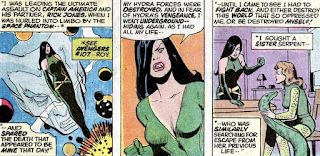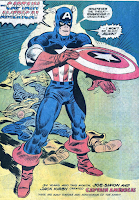ROGER STERN and JOHN BYRNE
CAPTAIN AMERICA 247 - 255
Roger Stern's and John Byrne's short stint on Cap is fondly remembered by fans and pros alike. When asked why, Byrne (in Back Issue 41) said he's given up trying to figure out why anyone likes or doesn't like anything but offered the quote above.
He might be onto something. Nothing earth-shattering happens here - if I had to liken it to a previous entry, it'd be the second Kirby run, minus the unfortunately wonky art from the King - but there is a sense of the book's creative team having a good time just making comics the way comics used to be made. (Elvis voice) Just TCOB, a-huh-a-hey-a.
Not that it's fluff, just that there's no ax to grind, no big message to hammer home, just Cap fighting Dragon Man and Nazi robots and Baltroc the Leaper ("Sacre bleu, mon capitan!") and Mister Hyde and what not.
 |
| As well as homages to Trek and 60s Marvel. |
  |
| I am going to steal your girlfriend, Wood-ee! |
 |
| Hyde finally gets to crush some Cap-shield when Stern writes The Avengers a few years later. |
Byrne (and to a lesser extent Stern as well) developed a reputation as a "Mr. Fix It" for aspects of Marvel continuity by other writers he didn't approve of. Here, he and Stern only refit one aspect of the character, though it's an important one: Cap's origin.
During Steve Gerber's brief tenure on Cap, he offered up a new origin for Steve Rogers that (as summarized in the Stern/Byrne piece in that Back Issue mentioned above) "despite its various merits, (felt) more resonant with the zeitgeist of the Vietnam era than that of World War II America and violated existing continuity in several respects (...) Stern reconciled all of the earlier inconsistencies by explaining that Rogers underwent an experimental procedure during the war in which he was implanted with various false memories as a defense mechanism against interrogation should be captured by the enemy."
 |
| Kinda makes sense in a place like the Marvel Universe. |
 | |
| Otherwise their version of Cap's origin is pretty much what audiences saw in The First Avenger. |
 |
| Although FDR gives him his shield, not Howard Stark. |
They also fleshed out those aspects of Steve's personal life established by Roger McKenzie on the title - namely, Cap's freelance illustration career (something inoffensive enough but really, all of Cap's civilian jobs feel unnecessary) and his friends and neighbors at his apartment complex.
 |
| One in particular: |
 |
| Bernie Rosenthal, Steve's soon-to-be main squeeze. |
More from Mark DiFruscio's article in BI 41: "Although Bernie and Steve were about the same 'age' physiologically, culturally they had a May-December romance."
"Throughout these interludes,
Stern and Byrne invest Steve Rogers with an array of humanizing details,
allowing him to demonstrate moments of shyness, charm, and
self-deprecating humor. Rogers reveals himself to be a man who
comes home to an empty kitchen, pulls all-nighters to meet a deadline,
and doesn't even know the name of his local congressman."
In Cap 250 Cap is approached to run as an independent candidate in the 1980 election. That would have neatly solved the "how do we make Cap's civilian job exciting?" dilemma. He declines, of course; what's better? Vigilante symbol of all that is free and good, moving freely and autonomously amidst these amber waves of grain while dropping in to flirt with the Wasp over at the Mansion, or sitting on your duff in the Oval Office, writing executive officers and working on your jokes for the next Press Correspondents Dinner?
 |
| Not even a contest. |
The story yielded a What If story down the line that's kind of fun. In this one Cap says what the hell, runs for President, and wins.
 |
| This leads to the Red Skull (in disguise) doing the same in South America, and he lures President America to his doom. |
There's an awful lot of win on the Marie Severin-illustrated cover, though:
Let's start with the faces in the crowd. I won't try to identify all the real-world people, but you can see Smilin' Stan (I think) to the above-right of Cap's head. And Marie made Kirby Chief Justice of the Supreme Court. Which, I mean, if I were President, I'd nominate him, if only to have a seriously awesome set of illustrated dissents for the Library of Congress.
I like how Reed and Sue and the Thing are present but no Johnny Storm. Makes sense - he'd be a security risk. All the FF would be, probably. The Secret Service would have a hell of a time keeping up with the dangers of a super-powered Presidency. But it also got me thinking of who would Cap put together for his cabinet? Is the Thing there to indicate a cabinet position? Secretary of Clobberin' Time?
 |
| When this scene plays out inside the issue itself, the FF (and Kirby) are not present. |
Finally, there's a nice nod to Invaders-era Cap in issue 253 and 254, when Cap is called overseas to the Farnsworth estate. Cap knew both elder (Union Jack) and daughter (Spitfire) during the war, as well as whom the elder suspects has returned: Baron Blood, that dastardly vampire with the National Socialist leanings.
 |
| I keep meaning to reread Invaders one of these days. I really loved that series when I discovered it (ten years after its cancellation) in high school. |
 |
| Again, Cap's man-out-of-time-ness rears its head. |
 |
| "Are you accusin' me of bein' a bleedin' Nazi vampire?!" Well, sure, you put it like that... |
  |
| Cap takes out the Baron in decisive fashion: |
From the moment we see frail Lord Farnsworth in his wheelchair, two things are all but inevitable: he will don the Union Jack colors again, and he will die of a heart attack for the effort. Sure enough, so it goes. The end page is a nice splash and has this nice dedication, which I'm happy to end on since it goes some small way to all my snarky comments on Frank Robbins' art ("Roscoe!!") last time. The artist deserves all possible accolades, and this is a nice two-parter in his memory.
~
NEXT: Deathlok the Demolisher! See you then.

















































































